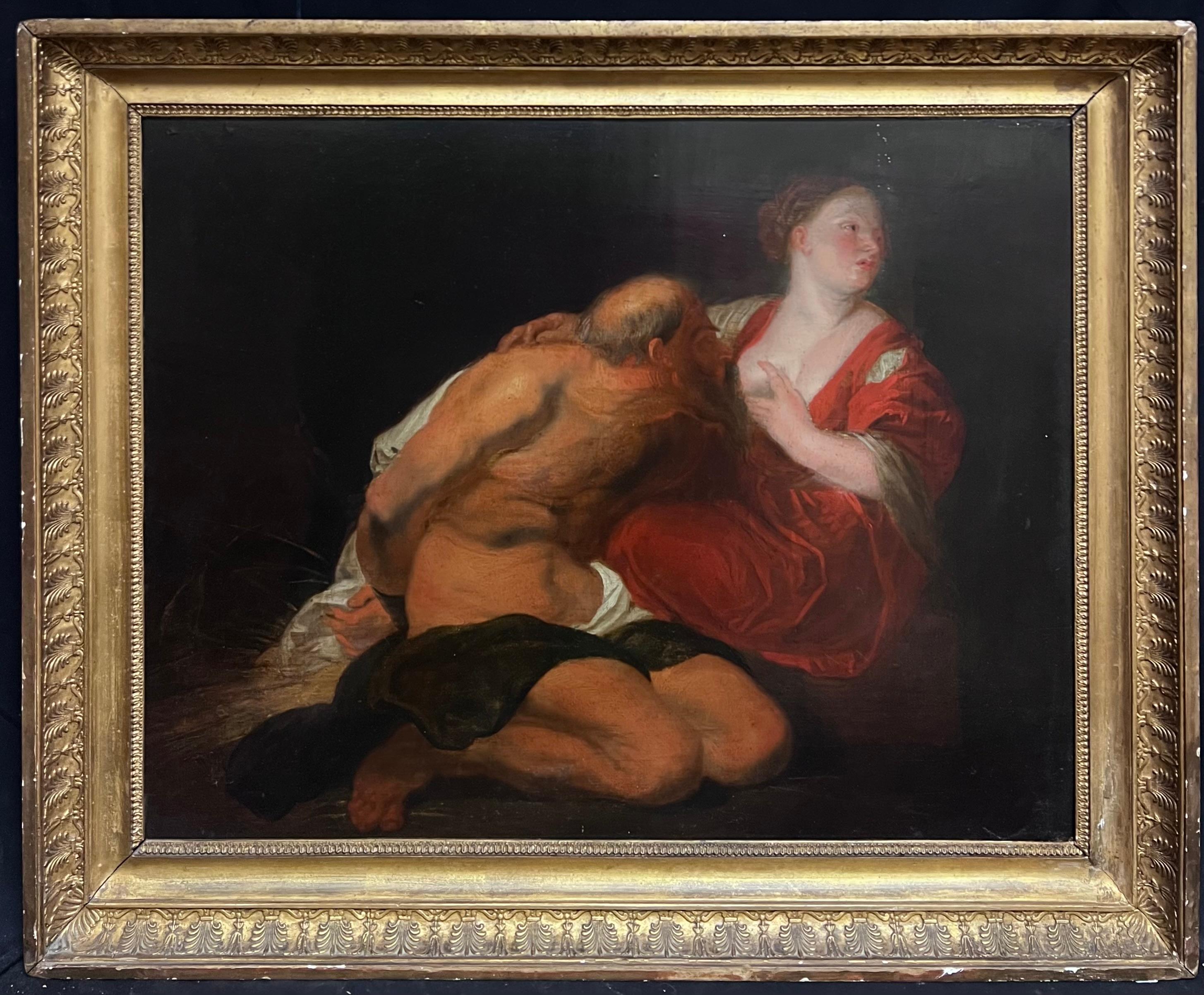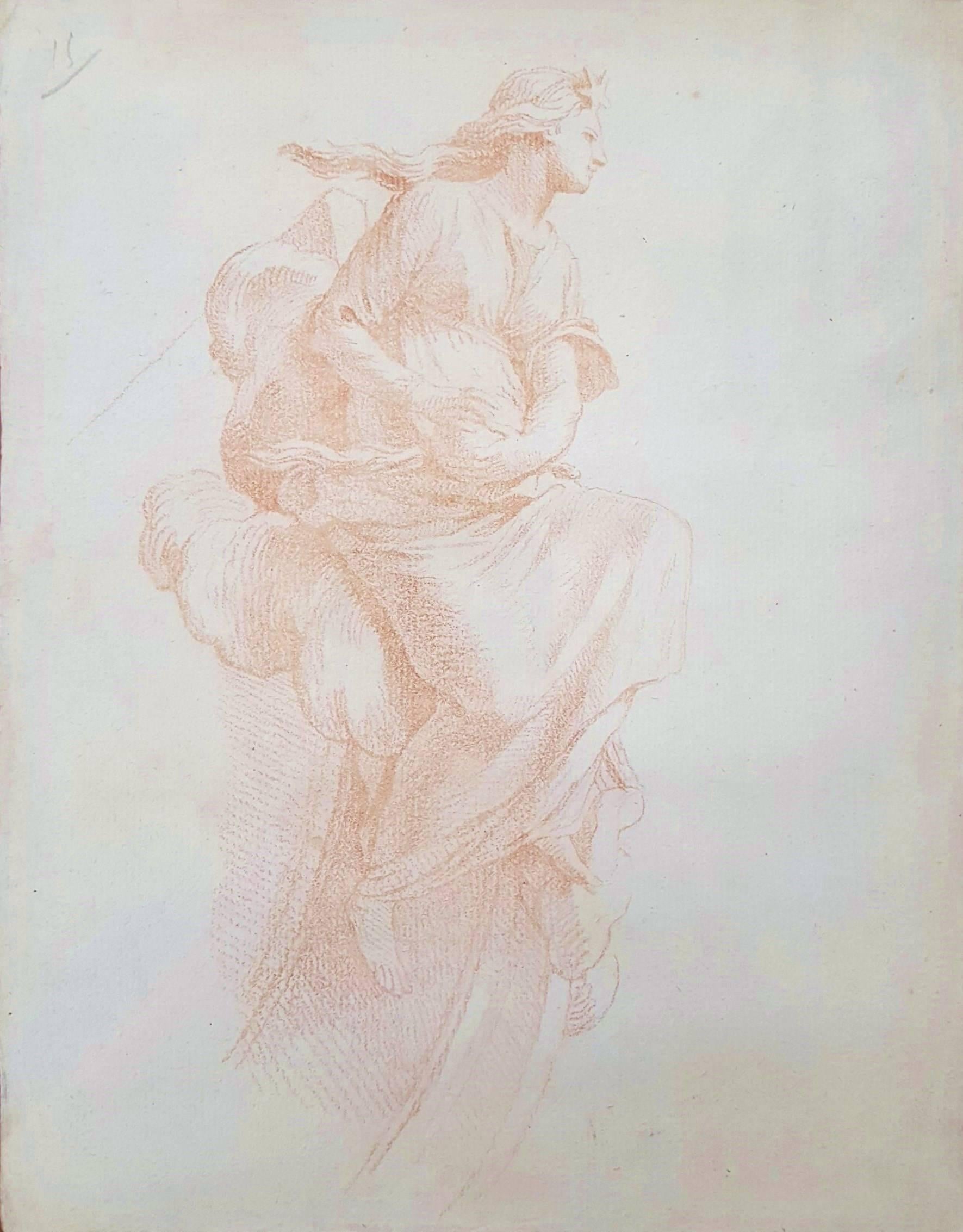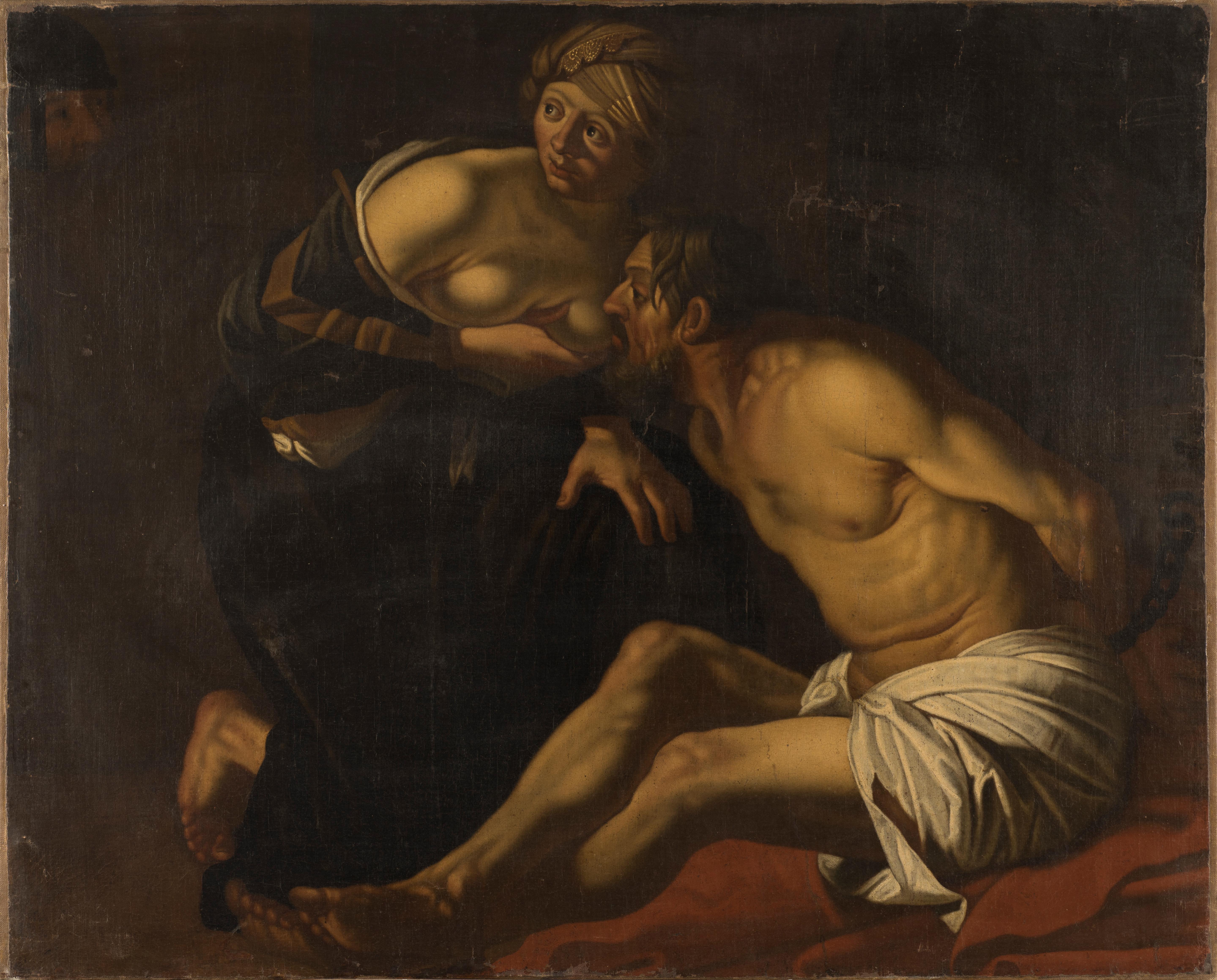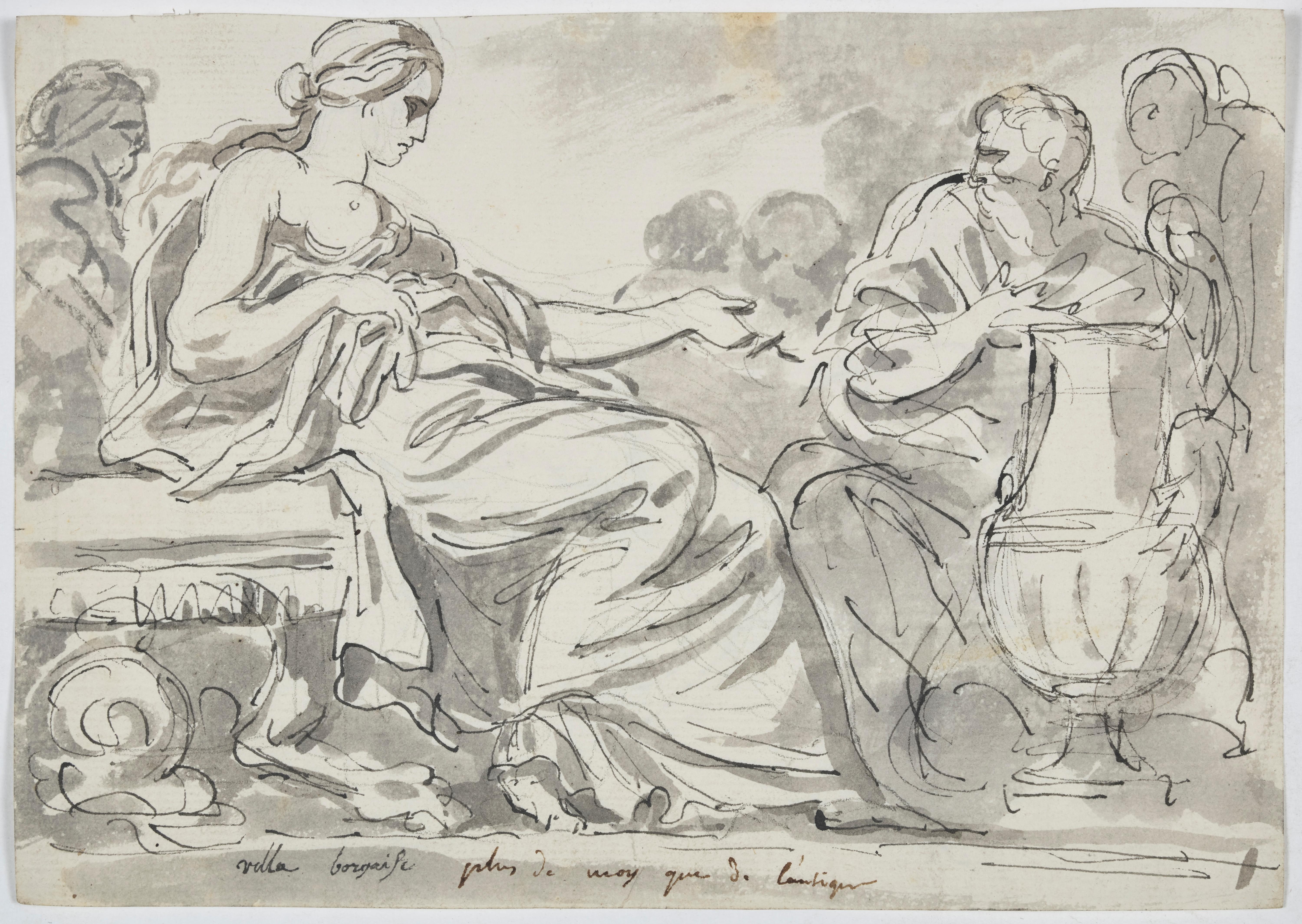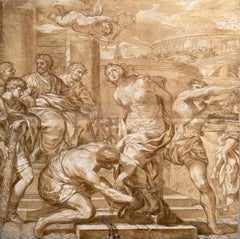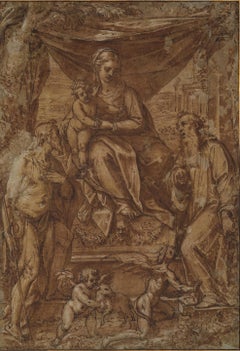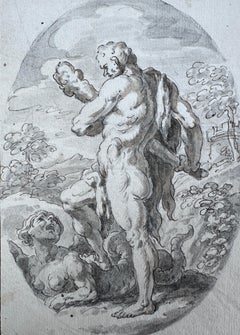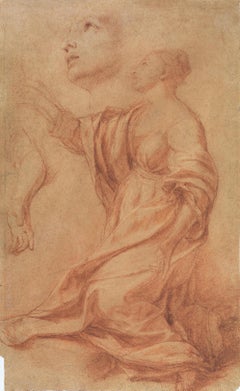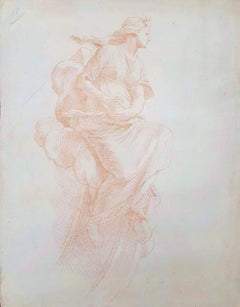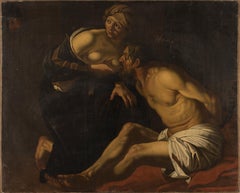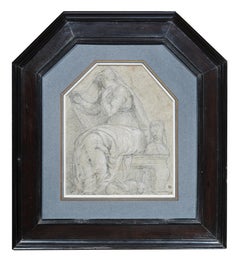Items Similar to Roman Charity (Cimon and Pero)
Want more images or videos?
Request additional images or videos from the seller
1 of 4
Michel Corneille the YoungerRoman Charity (Cimon and Pero)c. 1690
c. 1690
$11,358.61
£8,399.48
€9,500
CA$15,718.62
A$17,501.72
CHF 9,107.55
MX$211,242.40
NOK 114,217.12
SEK 107,885.26
DKK 72,343.02
About the Item
Michel CORNEILLE the Younger (Paris, 1642 – 1708)
Roman Charity (Cimon and Pero)
Black chalk with white highlights on beige paper
Height: 28 cm – Width: 20 cm
Unsigned
France, circa 1690
An important rediscovered drawing by Michel Corneille the Younger, one of the leading French history painters under Louis XIV. Admitted to the Royal Academy in 1663, Corneille worked for the celebrated collector Everhard Jabach and executed major royal commissions, including at Versailles. He was also a remarkably gifted draughtsman.
This moving sheet depicts the ancient subject of Roman Charity with striking graphic intensity and dramatic power. The upward gaze of Pero recalls the sibyls popularized by Guido Reni, while the bearded, balding head of Cimon — seen in profile — is a recurring type in Corneille’s oeuvre, both painted and drawn.
The composition draws inspiration from a painting then attributed to Guido Reni (acquired by Louis XIV in 1682), but the execution and characterization clearly reveal Corneille’s hand.
The drawing likely dates from around 1690, during the artist’s mature period, when his line reached a confident blend of movement, tension, and psychological depth.
Full scholarly notice by art historian François Marandet available upon request.
Provenance: former English art trade.
Please contact us for further information, high-resolution images, or a private viewing.
- Creator:Michel Corneille the Younger (1642 - 1708, French)
- Creation Year:c. 1690
- Dimensions:Height: 11.03 in (28 cm)Width: 7.88 in (20 cm)
- Medium:
- Movement & Style:
- Period:Late 17th Century
- Condition:
- Gallery Location:Paris, FR
- Reference Number:1stDibs: LU2258216450412
About the Seller
No Reviews Yet
Vetted Professional Seller
Every seller passes strict standards for authenticity and reliability
Established in 2010
1stDibs seller since 2022
Typical response time: 8 hours
- ShippingRetrieving quote...Shipping from: Saint-Sylvestre, France
- Return Policy
Authenticity Guarantee
In the unlikely event there’s an issue with an item’s authenticity, contact us within 1 year for a full refund. DetailsMoney-Back Guarantee
If your item is not as described, is damaged in transit, or does not arrive, contact us within 7 days for a full refund. Details24-Hour Cancellation
You have a 24-hour grace period in which to reconsider your purchase, with no questions asked.Vetted Professional Sellers
Our world-class sellers must adhere to strict standards for service and quality, maintaining the integrity of our listings.Price-Match Guarantee
If you find that a seller listed the same item for a lower price elsewhere, we’ll match it.Trusted Global Delivery
Our best-in-class carrier network provides specialized shipping options worldwide, including custom delivery.More From This Seller
View AllThe Torture of Saint Concordia
By Domenico Piola the Elder
Located in Paris, Île-de-France
Circle of Domenico Piola (Genoa 1627 – 1703)
The Torture of Saint Concordia
Black chalk, brown ink and brown wash on two sheets of paper,
40.5 x 42 cm
Unsigned
Provenance:
Estate...
Category
17th Century Old Masters Figurative Drawings and Watercolors
Materials
Ink
Virgin and Child with Saint John the Baptist and Saint Jerome
Located in Paris, Île-de-France
Felice Pinariccio, known as Le Lasagna (active in Bologna during the 1560s-1570s)
Virgin and Child with Saint John the Baptist and Saint Jerome
Pen and brown ink, brown wash heighte...
Category
16th Century Old Masters Figurative Drawings and Watercolors
Materials
Ink
Hercules vanquishing a drakaina (half‑woman, half‑serpent)
By Giovanni Domenico Tiepolo
Located in Paris, Île-de-France
Circle of Giovanni Domenico Tiepolo (Venice 1727 – Madrid 1804)
Hercules vanquishing a drakaina (half‑woman, half‑serpent) – interpreted either as Echidna or a personified Hydra
c. ...
Category
18th Century Old Masters Figurative Drawings and Watercolors
Materials
Ink
Studies of a kneeling female figure, an arm, a hand, and a head in profile
By Carlo Maratta (Ancona 1625 - Rome 1713)
Located in Paris, Île-de-France
Studio of Carlo Maratti (or Maratta)
Camerano 1625 – Rome 1713
Studies of a kneeling female figure, an arm, a hand, and a head in profile
Red chalk on paper
43.4 x 26.6 cm
Unsigne...
Category
Late 17th Century Old Masters Figurative Drawings and Watercolors
Materials
Chalk
The Holy Family with the Infant Saint John the Baptist
By Raphael (Raffaello Sanzio da Urbino)
Located in Paris, Île-de-France
STUDIO OF RAFFAELLO SANZIO, called RAPHAEL
(Urbino 1483 – Rome 1520)
Title The Holy Family with the Infant Saint John the Baptist
Medium Pen and brown ink, brown wash, over black ch...
Category
16th Century Old Masters Figurative Drawings and Watercolors
Materials
Ink
Man on Horseback Abducting a Woman
Located in Paris, Île-de-France
Jean-Robert ANGO (Active 1759 – 1773)
Man on Horseback Abducting a Woman
Red chalk and white chalk
26.1 x 25.9 cm
Provenance
Libert-Castor sale, November 19, 1993 (lot no. 23, ill...
Category
1760s Old Masters Animal Drawings and Watercolors
Materials
Chalk
You May Also Like
Fine 17th Century Flemish Baroque Oil Painting Roman Charity Large Wood Panel
Located in Cirencester, Gloucestershire
Roman Charity
Flemish Baroque period, first half 17th century
circle of Peter Paul Rubens
oil on wood panel, framed
framed: 24.5 x 30 inches
panel: 20 x 26 inches
Provenance: Private...
Category
17th Century Baroque Figurative Paintings
Materials
Oil
$21,724 Sale Price
30% Off
La Femme Muse /// Allegorical Symbolism Romantic Old Masters European Drawing
Located in Saint Augustine, FL
Artist: Unknown (Likely French, 18th Century)
Title: "La Femme Muse"
*No signature found
Circa: 1780
Medium: Original Pastel Drawing on heavy laid paper
Frami...
Category
1780s Old Masters Figurative Drawings and Watercolors
Materials
Pastel, Laid Paper
$1,200 Sale Price
78% Off
Roman Charity - Oil on Canvas After Dirck van Baburen
Located in Roma, IT
Roman Charity is a beautiful original oil painting on canvas, realized after a painting by Dirck van Baburen (1595-1624).
This painting depicts the ...
Category
Mid-17th Century Figurative Paintings
Materials
Canvas, Oil
Allegory of Chastity, a drawing attributed to G. Porta with great provenance
Located in PARIS, FR
This magnificent drawing from the Venetian Renaissance intrigues us in many ways. It depicts an allegorical composition whose meaning partly escapes us: a veiled figure seated on a stone bench (which we have identified as Chastity), seems to be turning away from a woman's bust beside her, below which are two rabbits, a traditional allegory of fertility, but also sometimes of lust.
This drawing, executed on blue paper, undoubtedly belongs to the Venetian Renaissance. The inscriptions on the back of the old mounting board indicate the various attributions considered by its last owner, the British painter and art historian Sir Lawrence Gowing. We have retained the attribution to Giuseppe Porta proposed by art historian John Arthur Gere as the most relevant.
We were incredibly fortunate to find a hexagonal frame of a very similar format for this drawing, the upper corners of which were formerly cut (irregularly). This 17th-century Dutch frame comes from an aristocratic collection in Lombardy, and creates a kind of fascinating chase around this Venetian drawing...
Category
16th Century Figurative Drawings and Watercolors
Materials
Chalk
Judith and Salome, a pair of oil paintings on canvas by Francesco Conti
Located in PARIS, FR
This widely referenced pair of paintings is one of Francesco Conti’s most successful productions. Francesco Conti is one of the finest painters of 18th-century Florence. In the shimmering colors typical of his best work, he represents two opposite characters from the Bible: the virtuous Judith, whose courage saves her people by cutting off the head of the invader Holofernes, and the depraved Salome, who under the influence of her mother becomes responsible for the beheading of the prophet John the Baptist.
The artist's talent lies in his ability to treat these two macabre subjects with a light touch, presenting us with two attractive women who seem to twirl with glee amidst the severed heads...
1. Francesco Conti, the “Florentine Tiepolo”
Francesco Conti is a major painter of the Florentine school of the 18th century; he can even probably be considered, along with Giovanni Domenico Ferretti (1692-1768), as one of the two main painters of the second quarter of the Florentine 18th century.
Born in Florence in 1682, Francesco Conti began his apprenticeship in the workshop of Simone Pignoni (1611 - 1698), a disciple of Francesco Furini; he was also influenced by the Venetian Sebastiano Ricci. A protégé of Marquis Riccardi, he accompanied him to Rome between 1699 and 1705, where he frequented Carlo Maratta's studio. He settled permanently in Florence in 1705.
Painted exclusively on canvas, the majority of his work consists of religious subjects, altarpieces or private devotional works. It is likely that Conti himself was a devout churchgoer, as evidenced by his affiliation, in the third decade of the eighteenth century, to the Society of the Disciples of Saint-John-the-Baptist, and his entry, at the end of his life, into the fraternity of the Venerable Society of the Holy Trinity.
In Florence, Conti worked for the Grand Duchy's major patrons, including the last Medici - in particular Giangastone and Annamaria Luisa, Electress Palatine - and confirmed his role as a reference painter under the Lorraine Regency, as master of the Public Drawing School, which was closely linked to the institute responsible for the manufacture of semi-precious stone mosaics, then located in the Uffizi complex.
Matteo Marangoni, an art critic of the early 20th century, praised his "brushwork full of elegance and true spirit of the 18th century", pointing out that Conti was "probably one of the best colorists" of the Florentine school of his time. These two characteristics led the art historian Paolo dal Poggetto to nickname him the "Florentine Tiepolo".
2. Judith and Salome, two biblical characters opposing each other
These two paintings form a pair presenting two biblical episodes, which have in common the depiction of a "heroine" carrying the severed head of a man.
While the Salome episode might at first appear to be an echo of the Old Testament story of Judith, each character is the exact opposite of the other. Judith, whose story is told in the Book of Judith, is a beautiful young widow from Bethulia who, accompanied by her maid, went into the camp of the invading Assyrians and won the confidence of Holofernes, the general commanding the enemy army. Invited to a great feast on the fourth evening, she took advantage of Holofernes' drunkenness to cut off his head. “She went up to the bedpost near Holofernes’ head, and took down his sword that hung there. She came close to his bed, took hold of the hair of his head, and said, “Give me strength today, O Lord God of Israel!” Then she struck his neck twice with all her might, and cut off his head. Next she rolled his body off the bed and pulled down the canopy from the posts. Soon afterward she went out and gave Holofernes’ head to her maid, who placed it in her food bag...
Category
1710s Old Masters Figurative Drawings and Watercolors
Materials
Canvas, Oil
Study in the Antique Style, a neoclassical drawing by Augustin Pajou
Located in PARIS, FR
In this lively and fresh drawing, probably taken from one of the artist's notebooks, Pajou presents us with a composition freely inspired by antiquity, as a souvenir of a visit to th...
Category
1750s Old Masters Figurative Drawings and Watercolors
Materials
Ink
